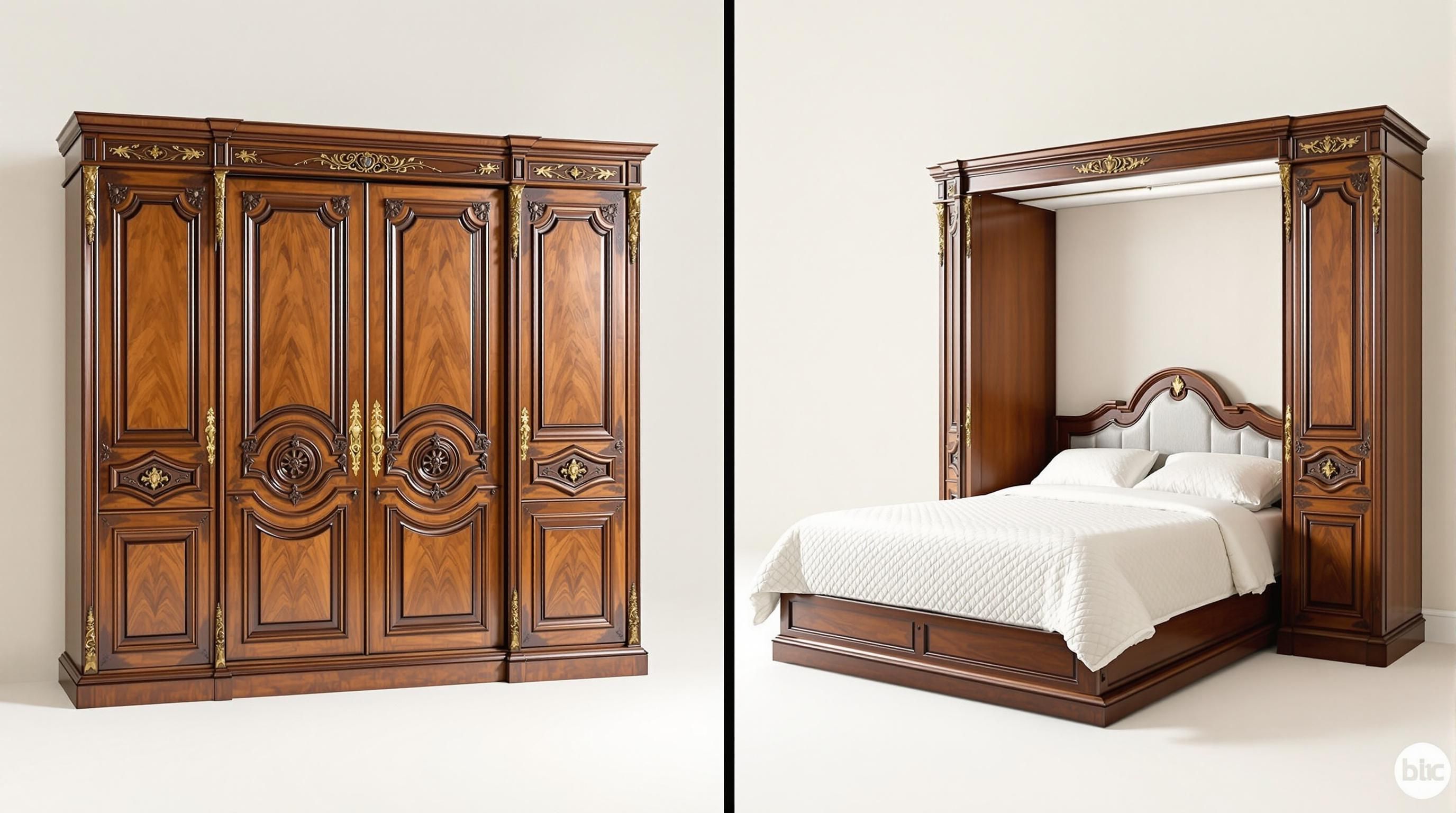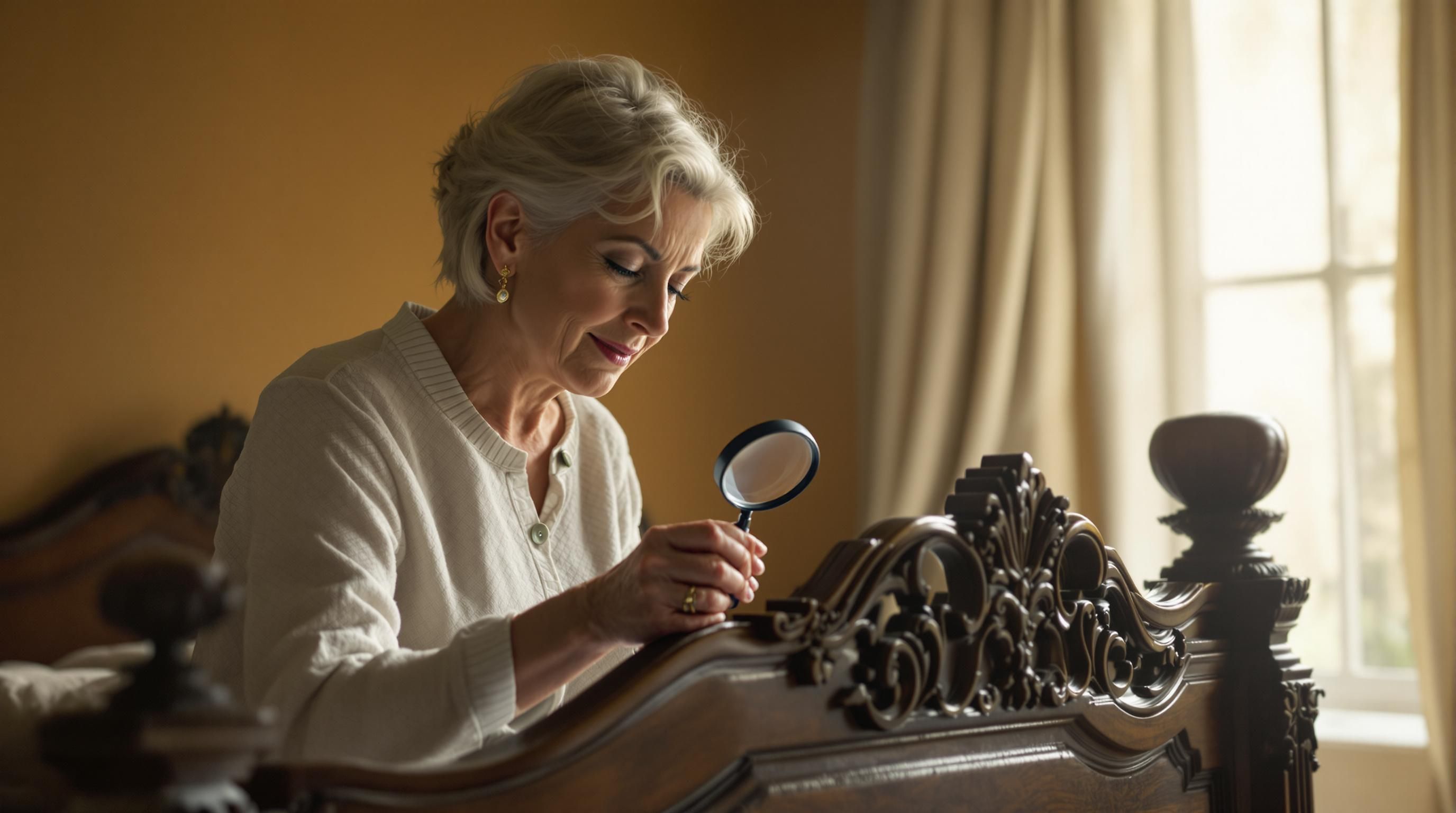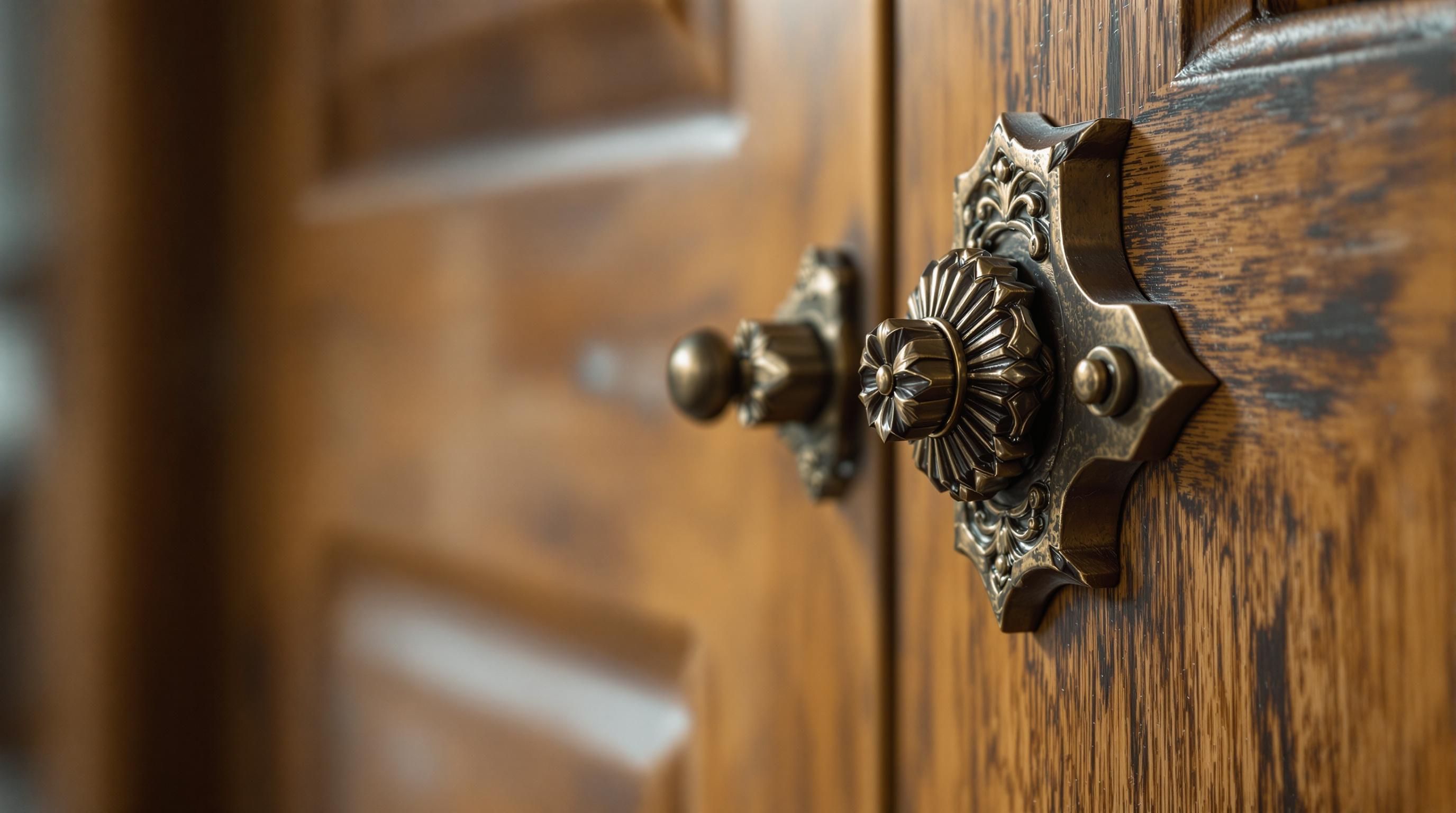Antique Murphy Bed Value: Complete Collector’s Guide
Murphy beds, those ingenious space-saving fold-up beds that tuck neatly into walls or cabinets, have been around since the late 19th century. Today, antique Murphy beds from the early 1900s have become sought-after collectibles, valued for their craftsmanship, historical significance, and practical functionality. But determining the worth of these vintage wall beds can be challenging for collectors and sellers alike.
In this comprehensive guide, we’ll explore the factors that affect antique Murphy bed values, current market prices, and how to identify authentic pieces worth investing in. Whether you’ve inherited one of these space-saving marvels or are considering adding one to your collection, this article will help you navigate the specialized market for these unique furniture pieces.
The History of Murphy Beds
The Murphy bed was invented by William Lawrence Murphy around 1900 in San Francisco. Legend has it that Murphy was living in a one-room apartment and wanted to entertain guests, particularly a female opera singer he was courting. Due to the social norms of the time, it was improper to have a bed in a room where one entertained guests, so he created a fold-up bed that could be hidden in a closet.
Murphy patented his “Disappearing Bed” in 1908 and founded the Murphy Wall Bed Company. The beds gained enormous popularity in the early 20th century, particularly in growing urban areas where space was at a premium. The original Murphy beds were typically made of high-quality oak, mahogany, or walnut with ornate carvings that matched other furniture styles of the era.
Evolution of Murphy Beds
- 1900
Original Invention
William Lawrence Murphy develops his first fold-up bed design in San Francisco. - 1908
First Patent
Murphy receives the patent for his "Disappearing Bed" design. - 1910-1925
Peak Popularity
Murphy beds become extremely popular during the housing boom, with ornate wooden cabinets matching prevalent interior design styles. - 1925-1940
Art Deco Influence
Murphy bed designs incorporate Art Deco elements with simpler lines and geometric patterns. - 1950s
Decline
Post-war housing boom and larger homes lead to decreased demand for space-saving furniture. - 1980s-Present
Renewed Interest
Revival of interest in both modern Murphy beds and antique versions as collectibles.
Factors Affecting Antique Murphy Bed Values
Age and Authenticity
The older the Murphy bed, generally the more valuable it is. Pieces from the 1900-1920 period, especially those with verifiable provenance or original documentation, command premium prices. Early models with the original Murphy Wall Bed Company markings or patent stamps can be particularly valuable.
Materials and Construction
Most antique Murphy beds were constructed from solid hardwoods:
- Oak: The most common material, particularly quarter-sawn oak in the Craftsman or Mission style
- Mahogany: Used in more upscale models
- Walnut: Less common but highly valued
- Combination of woods with decorative veneers
The quality of wood, joinery methods, and hardware all factor into the valuation. Hand-crafted details like dovetail joints and mortise-and-tenon construction indicate higher quality and thus higher value.
Design and Decorative Elements
The style and ornamentation of the bed cabinet significantly impact value:
- Victorian-style beds with elaborate carvings and embellishments
- Arts and Crafts/Mission style with straight lines and visible joinery
- Art Deco models with geometric patterns and streamlined designs
Murphy beds designed to look like other furniture pieces when folded up (such as bookcases, desks, or dressers) tend to be more valuable due to their dual functionality and clever design.
Condition
As with all antiques, condition is paramount:
- Original finish in good condition
- Functional mechanical components
- Intact hardware (handles, hinges, springs)
- Minimal repairs or replacements
- Structural integrity
A bed with its original spring mechanism in working order will be worth significantly more than one that requires restoration or has been modified.
Size and Practicality
Full-size or queen-size Murphy beds tend to be more valuable than twin sizes because they have broader appeal to modern buyers. Additionally, beds with dimensions that can accommodate modern mattresses without modification will command higher prices.
Completeness
An antique Murphy bed with all its original components intact is worth considerably more than one missing parts:
- Original mattress platform and springs
- All decorative elements and hardware
- Accompanying headboard or footboard (if the original design included them)
- Integrated features like lighting or storage compartments
Key Value Indicators
Current Market Values
The value of antique Murphy beds can vary widely based on the factors listed above. Here’s a breakdown of current market values as of 2024:
Antique Murphy Bed Price Ranges
Current market values based on condition and features
</tbody>
</table>
According to recent sales data, an antique Victorian era Murphy bed in good condition typically sells for $1,200 to $2,000. Expert appraisers from JustAnswer have valued late 19th century Victorian era wooden frame folding Murphy beds between $1,200 and $2,000, which aligns with current market trends.
Reddit antique experts suggest that exceptional examples can be worth $2,500-$3,000, though they note that finding buyers can be challenging due to the size and shipping difficulties associated with these large furniture pieces.
Recent Antique Murphy Bed Sales
Notable sales from auctions and marketplaces
| Category | Price | Notes |
|---|---|---|
| Entry-Level/Project Beds | $400-$1,000 | Basic designs requiring restoration, incomplete units, or beds with significant wear |
| Mid-Range/Good Condition | $1,200-$2,000 | Complete beds in working condition with typical wear for age |
| High-End/Excellent Condition | $2,500-$3,800 | Rare designs, exceptional craftsmanship, or beds with special features in pristine condition |
| Museum-Quality/Exceptional Pieces | $4,000-$7,500+ | Very early examples with provenance, unique designs, or beds with historical significance |
</tbody>
</table>

It’s worth noting that geographic location can significantly impact pricing. Urban areas where space is limited, such as New York City or San Francisco, often see higher demand and thus higher prices for Murphy beds, both antique and modern.
How to Identify an Authentic Antique Murphy Bed
Patent Markings and Labels
Authentic Murphy beds from the early 1900s often include:
- Patent stamps or metal plates with patent dates (look for Pat. 1908, 1912, or 1916)
- “Murphy Door Bed Company” or “Murphy Wall Bed Company” labels
- Serial numbers stamped into the metal hardware
Construction Methods
Examine the construction techniques used:
- Hand-cut dovetail joints in drawers and cabinet components
- Mortise-and-tenon joinery
- Cut nails or square head screws (rather than Phillips head)
- Quarter-sawn oak or other period-appropriate hardwoods
- Hand-carved decorative elements
Hardware Analysis
The hardware provides significant clues to authenticity:
- Cast iron or brass hinges and mechanisms
- Strong coil springs (often manufactured by companies like Seng)
- Hand-forged or early machine-made components
- Patina and wear consistent with age
Style and Design Elements
Different periods had characteristic design elements:
- Early models (1900-1915): Often featured heavy Victorian or Edwardian styling
- 1915-1925: Arts and Crafts/Mission influence with straight lines and visible joinery
- 1925-1940: Art Deco influences with geometric patterns and streamlined forms
Signs of Age and Use
Look for natural aging that’s difficult to fake:
- Even patina across wooden surfaces
- Wear patterns consistent with functional use
- Original finish that shows appropriate aging
- Minor repairs that match the period
Antique Murphy Bed Authentication Checklist
Use this checklist to assess whether a Murphy bed is genuinely antique
- Patent markings from 1908-1925
- Period-appropriate wood (quarter-sawn oak, mahogany, etc.)
- Hand-cut joinery (dovetails, mortise-and-tenon)
- Cast iron or brass hardware with appropriate patina
- Design elements consistent with 1900-1940 styles
- Original finish or period-appropriate refinishing
- Natural wear patterns consistent with age and use
- Murphy Door Bed Company or similar manufacturer markings
Restoration Considerations
Value Impact of Restoration
The effect of restoration on value depends largely on the approach taken:
- Conservative Restoration: Preserving as much original material as possible while ensuring functionality typically maintains or increases value.
- Overzealous Modernization: Replacing original components with modern equivalents, stripping original finishes, or modifying the design can significantly decrease value to collectors.
- Structural Repairs: Necessary repairs to ensure safety and function generally don’t negatively impact value if done sympathetically.
Restoration Best Practices
If you decide to restore an antique Murphy bed:
- Document Everything: Take detailed photographs before beginning any work.
- Research: Study the specific model and manufacturer to understand original specifications.
- Consult Experts: Work with restoration specialists who understand antique furniture mechanisms.
- Preserve Original Elements: Keep as many original components as possible.
- Use Period-Appropriate Materials: If replacements are necessary, use similar materials and techniques.
- Address Safety Issues: Ensure the restored bed is safe for use while maintaining period authenticity.
Common Restoration Challenges
Restorers of antique Murphy beds frequently encounter these issues:
- Spring Mechanism Problems: Original springs may be worn or broken and require careful replacement.
- Wood Repairs: Fixing splits, cracks, or weak joints without compromising the appearance.
- Hardware Replacements: Finding appropriate period hardware if originals are missing.
- Finish Restoration: Reviving the original finish without completely stripping and refinishing.
- Mattress Support Adaptation: Modifying to accommodate modern mattresses while preserving the original look.

Where to Buy and Sell Antique Murphy Beds
Best Places to Find Antique Murphy Beds
Online Marketplaces
- eBay: Offers a wide selection with detailed photos and descriptions
- Etsy: Features unique, often restored pieces from small dealers
- 1stDibs: Specializes in higher-end antiques with verified authenticity
Local Sources
- Estate sales and auctions
- Architectural salvage companies
- Antique furniture dealers
- Facebook Marketplace and Craigslist (often better prices but require careful evaluation)
Specialized Dealers
- Antique furniture restoration shops
- Dealers specializing in early 20th century furniture
- Historical building renovation suppliers
Selling Tips
If you’re looking to sell an antique Murphy bed:
- Complete Documentation: Gather any available history, receipts, or documentation about the piece.
- Professional Appraisal: Consider getting a formal appraisal from an antique furniture specialist.
- Quality Photography: Take clear, well-lit photos showing all aspects of the bed, both open and closed.
- Detailed Description: Include accurate measurements, wood type, condition notes, and any known history.
- Reasonable Expectations: Understand that these large pieces may take time to sell and often require local pickup.
- Consider Consignment: Specialized antique dealers may offer consignment arrangements for higher-end pieces.
Shipping Considerations
One of the biggest challenges with antique Murphy beds is transportation:
- Local sales are often more practical due to size and weight
- Professional furniture movers may be required for safe transport
- Disassembly may be necessary but should be done by experienced handlers
- Insurance during shipping is essential for these valuable pieces
Investment Potential
Market Trends
The market for antique Murphy beds has shown interesting patterns:
- Increasing Scarcity: As these beds age, fewer examples remain in good condition, potentially driving up prices.
- Renewed Interest: The trend toward smaller, more efficient living spaces has increased interest in space-saving furniture like Murphy beds.
- Selective Appreciation: The highest quality examples from recognized manufacturers show the strongest appreciation.
- Practical Limitations: The size and specialized nature of these pieces limit the buyer pool, affecting liquidity.
Investment Considerations
If considering antique Murphy beds as an investment:
- Condition is Critical: Only pieces in excellent original condition or expertly restored examples tend to appreciate significantly.
- Provenance Adds Value: Documented history, especially from notable buildings or owners, can substantially increase value.
- Storage Challenges: The size of these pieces creates significant storage costs if not in use.
- Long-term Horizon: These should generally be viewed as long-term investments rather than quick flips.
- Dual-Purpose Value: The practical functionality combined with aesthetic and historical value provides some insulation against market fluctuations.
Who is Buying?
Understanding the buyer market helps assess investment potential:
- Historical property renovators seeking period-appropriate fixtures
- Boutique hotels creating themed or historical rooms
- Design professionals specializing in vintage interiors
- Space-conscious urban dwellers with an appreciation for antiques
- Furniture collectors focusing on innovative or mechanical pieces
Common Questions About Antique Murphy Beds
How much is an antique Murphy bed worth?
How can I tell if my Murphy bed is antique?
Look for these key indicators to identify an authentic antique Murphy bed:
- Patent stamps or metal plates with early dates (1908-1925)
- “Murphy Door Bed Company” or “Murphy Wall Bed Company” markings
- Hand-cut joinery like dovetails and mortise-and-tenon construction
- Period-appropriate hardwoods like quarter-sawn oak or mahogany
- Cast iron or brass hardware with a natural patina
- Design elements consistent with early 20th century styles
- Square head screws or cut nails rather than Phillips head screws
Do antique Murphy beds increase home value?
How old does a Murphy bed need to be to be considered antique?
What is the most valuable type of antique Murphy bed?
The most valuable antique Murphy beds typically feature these characteristics:
- Early production dates (1900-1920)
- Original patent stamps and manufacturer markings
- Exceptional craftsmanship with hand-carved details
- Rare woods or distinctive design elements
- Dual-purpose functionality (e.g., beds that fold into desks or bookshelves)
- Complete original hardware and mechanisms in working order
- Documented provenance from significant buildings or owners
Eastlake style and Victorian Murphy beds with ornate carvings and original finish in excellent condition command the highest prices in today’s market.
Should I restore my antique Murphy bed or sell it as is?
This decision depends on several factors:
- Current Condition: If the bed is in poor but complete condition, careful restoration may increase its value.
- Completeness: If many original parts are missing, restoration costs may exceed the resulting value increase.
- Your Expertise: DIY restoration by inexperienced hands can decrease value; professional restoration is recommended.
- Intended Market: Serious collectors often prefer pieces with original patina and minor wear over heavily restored examples.
- Personal Use: If you plan to use the bed yourself, functionality-focused restoration makes more sense.
Generally, conservation (stabilizing and preserving the original) rather than full restoration is the safer approach for maintaining value.
Can antique Murphy beds accommodate modern mattresses?
Many antique Murphy beds require adaptation to fit modern mattresses, which tend to be thicker than those from the early 20th century. Some considerations:
- Original Murphy beds typically accommodated mattresses 5-6 inches thick, while modern mattresses are often 10-14 inches thick
- The bed mechanism may need adjustment to support the additional weight
- Some collectors modify the frame while preserving the external cabinet and hardware
- Memory foam or hybrid mattresses designed for Murphy beds (typically 6-8 inches thick) can be a good compromise
- Professional modification by a restoration specialist can adapt the bed while maintaining its antique character
What sizes were antique Murphy beds typically made in?
Antique Murphy beds were commonly made in these sizes:
- Three-quarter size (approximately 48" x 75")
- Full/double size (approximately 54" x 75")
- Twin size (approximately 39" x 75")
True queen and king sizes were not standard in the early Murphy bed era, as these larger mattress sizes didn’t become commonplace until the mid-20th century. The dimensions of antique beds often don’t precisely match modern standard sizes, which can be a consideration when planning to use an antique Murphy bed with a contemporary mattress.
External Resources for Antique Murphy Bed Collectors
eBay Antique Murphy Bed Listings
Browse current listings of antique Murphy beds from the 1900-1950 period, with price ranges and detailed photographs to help establish current market values.
Etsy Antique Murphy Bed Market
Explore handpicked antique and vintage Murphy beds from small dealers and restoration specialists, often featuring unique pieces with detailed histories.
1stDibs Murphy Bed Collection
High-end antique marketplace featuring premium Murphy beds with verified authenticity and detailed provenance information from reputable dealers.
JustAnswer Antique Furniture Appraisals
Professional online appraisal service with experts who provide value estimates for antique furniture including Murphy beds, with examples of past appraisals.
Reddit Antiques Community
Active community of antique collectors and experts who share knowledge about identification, valuation, and restoration of antique furniture including Murphy beds.
Salado Creek Antiques
Specialized dealer featuring high-quality antique furniture including Murphy beds, with detailed descriptions and professional photography of available pieces.
Conclusion: Are Antique Murphy Beds Worth the Investment?
Antique Murphy beds represent a fascinating intersection of historical innovation, craftsmanship, and practical functionality. As space-saving solutions regain popularity in modern living, these ingenious pieces from the early 20th century offer both aesthetic appeal and utility.
From an investment perspective, the most valuable examples are those with documented provenance, excellent original condition, and distinctive design elements. While not as liquid as some other antiques due to their size and specialized nature, the finest Murphy beds have shown steady appreciation over time, particularly as fewer original examples remain available.
For collectors, the joy of owning these pieces often extends beyond financial considerations. The mechanical ingenuity, historical significance, and the stories they tell about changing domestic spaces all contribute to their appeal. Whether displayed in a period-appropriate setting or adapted for modern use, antique Murphy beds continue to captivate with their clever solution to an enduring challenge: making the most of limited space with style and elegance.
If you’re considering buying or selling an antique Murphy bed, take time to research the specific model, consult with experts, and understand both its historical context and current market position. With proper care and appreciation, these remarkable pieces can continue to serve and delight for another century.
Get a Professional Appraisal
Unsure about your item’s value? Our certified experts provide fast, written appraisals you can trust.
- Expert report with photos and comps
- Fast turnaround
- Fixed, upfront pricing
No obligation. Secure upload.
| Item | Price | Date | Auction House |
|---|---|---|---|
| Eastlake Style Antique Oak Murphy Bed | $2,699 | September 2024 | Salado Creek Antiques |
| Victorian Oak Murphy Bed with Original Hardware | $1,875 | July 2024 | eBay |
| Antique Murphy Bed in Like-New Condition | $1,000 | August 2024 | Facebook Marketplace |
| 1920s Murphy Bed with Decorative Front Panel | $2,200 | June 2024 | Local Auction |




